
Hãy nhập câu hỏi của bạn vào đây, nếu là tài khoản VIP, bạn sẽ được ưu tiên trả lời.


a.
Đường tròn (C): \(x^2+y^2-6x+4y+12=0\) có tâm \(J\left(3;-2\right)\) bán kính \(r=1\)
Tiếp điểm A của 2 đường tròn phải nằm trên đường nối tâm IJ
\(\overrightarrow{JI}=\left(3;4\right)\Rightarrow\) phương trình IJ có dạng:
\(4\left(x-3\right)-3\left(y+2\right)=0\Leftrightarrow4x-3y-18=0\)
Tọa độ tiếp điểm A là nghiệm của hệ :
\(\left\{{}\begin{matrix}4x-3y-18=0\\x^2+y^2-6x+4y+12=0\end{matrix}\right.\)
\(\Leftrightarrow\left\{{}\begin{matrix}y=\dfrac{4x-18}{3}\\x^2+y^2-6x+4y+12=0\end{matrix}\right.\)
\(\Rightarrow x^2+\left(\dfrac{4x-18}{3}\right)^2-6x+4\left(\dfrac{4x-18}{3}\right)+12=0\)
\(\Rightarrow\dfrac{25}{9}x^2-\dfrac{50}{3}x+24=0\)
\(\Rightarrow\left[{}\begin{matrix}x=\dfrac{12}{5}\Rightarrow y=-\dfrac{14}{5}\\x=\dfrac{18}{5}\Rightarrow y=-\dfrac{6}{5}\end{matrix}\right.\)
\(\Rightarrow\left[{}\begin{matrix}A\left(\dfrac{12}{5};-\dfrac{14}{5}\right)\\A\left(\dfrac{18}{5};-\dfrac{6}{5}\right)\end{matrix}\right.\)
\(\Rightarrow\left[{}\begin{matrix}\overrightarrow{AI}=\left(\dfrac{18}{5};\dfrac{24}{5}\right)\\\overrightarrow{AI}=\left(\dfrac{12}{5};\dfrac{16}{5}\right)\end{matrix}\right.\) \(\Rightarrow\left[{}\begin{matrix}R^2=AI^2=36\\R^2=AI^2=\dfrac{36}{5}\end{matrix}\right.\)
Có 2 đường tròn thỏa mãn:
\(\left[{}\begin{matrix}\left(x-6\right)^2+\left(y-2\right)^2=36\\\left(x-6\right)^2+\left(y-2\right)^2=\dfrac{36}{5}\end{matrix}\right.\)
b.
Đường tròn (C): \(x^2+y^2=4\) có tâm \(O\left(0;0\right)\) và bán kính \(r=2\)
Gọi \(I\left(a;b\right)\) là tâm của đường tròn (C') cần tìm
Do (C') tiếp xúc Ox \(\Rightarrow d\left(I;Ox\right)=3\Rightarrow\dfrac{\left|b\right|}{1}=3\Rightarrow b=\pm3\)
TH1: \(I\left(a;3\right)\Rightarrow\overrightarrow{OI}=\left(a;3\right)\Rightarrow OI=\sqrt{a^2+9}\)
Do 2 đường tròn tiếp xúc \(\Rightarrow\left[{}\begin{matrix}R+r=OI\\R-r=OI\end{matrix}\right.\)
\(\Rightarrow\left[{}\begin{matrix}OI=5\\OI=1\end{matrix}\right.\) \(\Rightarrow\left[{}\begin{matrix}\sqrt{a^2+9}=5\\\sqrt{a^2+9}=1\left(vn\right)\end{matrix}\right.\)
\(\Rightarrow a=\pm4\)
TH2: hoàn toàn tương tự ta có tìm được \(a=\pm4\)
Vậy có 4 đường tròn thỏa mãn: \(\left[{}\begin{matrix}\left(x-4\right)^2+\left(y-3\right)^2=9\\\left(x+4\right)^2+\left(y-3\right)^2=9\\\left(x-4\right)^2+\left(y+3\right)^2=9\\\left(x+4\right)^2+\left(y+3\right)^2=9\end{matrix}\right.\)

4b.
\(\dfrac{\pi}{2}< a< \pi\Rightarrow cosa< 0\Rightarrow cosa=-\sqrt{1-sin^2a}=-\dfrac{4}{5}\)
\(\Rightarrow tana=\dfrac{sina}{cosa}=-\dfrac{3}{4}\)
\(tan\left(a+\dfrac{\pi}{3}\right)=\dfrac{tana+tan\left(\dfrac{\pi}{3}\right)}{1-tana.tan\left(\dfrac{\pi}{3}\right)}=\dfrac{-\dfrac{3}{4}+\sqrt{3}}{1-\left(-\dfrac{3}{4}\right).\sqrt{3}}=...\)
c.
\(\dfrac{3\pi}{2}< a< 2\pi\Rightarrow cosa>0\Rightarrow cosa=\sqrt{1-sin^2a}=\dfrac{5}{13}\)
\(cos\left(\dfrac{\pi}{3}-a\right)=cos\left(\dfrac{\pi}{3}\right).cosa+sin\left(\dfrac{\pi}{3}\right).sina=\dfrac{1}{2}.\dfrac{5}{13}+\left(-\dfrac{12}{13}\right).\dfrac{\sqrt{3}}{2}=...\)

5:
a: sin x=2*cosx
\(A=\dfrac{6cosx+2cosx-4\cdot8\cdot cos^3x}{cos^3x-2cosx}\)
\(=\dfrac{8-32cos^2x}{cos^2x-2}\)
b: VT=sin^4(pi/2-x)+cos^4(x+pi/2)+6*1/2*sin^22x+1/2*cos4x
=cos^4x+sin^4x+3*sin^2(2x)+1/2*(1-2*sin^2(2x))
=1-2*sin^2x*cos^2x+3*sin^2(2x)+1/2-sin^2(2x)
==3/2=VP



3.
Xét \(x^2-8x+7\le0\Leftrightarrow\left(x-1\right)\left(x-7\right)\le0\Rightarrow1\le x\le7\)
Có tập nghiệm \(D_1=\left[1;7\right]\)
Xét \(x^2-\left(2m+1\right)x+m^2+m\le0\Leftrightarrow\left(x-m\right)\left(x-m-1\right)\le0\)
\(\Leftrightarrow m\le x\le m+1\) có tập nghiệm là \(D_2=\left[m;m+1\right]\)
a. Hệ BPT vô nghiệm khi \(D_1\cap D_2=\varnothing\)
\(\Leftrightarrow\left[{}\begin{matrix}m>7\\m+1< 1\end{matrix}\right.\) \(\Rightarrow\left[{}\begin{matrix}m>7\\m< 0\end{matrix}\right.\)
b. Do \(D_2\) là đoạn có độ dài bằng \(m+1-m=1\) nên hệ có tập nghiệm là 1 đoạn dài 1 trên trục số khi: \(D_2\subset D_1\)
\(\Leftrightarrow\left\{{}\begin{matrix}m\ge1\\m+1\le7\end{matrix}\right.\) \(\Rightarrow1\le m\le6\)

Xét BPT: \(x^2-8x+15\le0\Leftrightarrow3\le x\le5\Rightarrow D_1=\left[3;5\right]\)
Xét BPT: \(\left(m^2+1\right)x+m\ge23+2mx\)
\(\Leftrightarrow\left(m^2-2m+1\right)x\ge23-m\)
\(\Leftrightarrow\left(m-1\right)^2x\ge23-m\) (1)
- Với \(m=1\Rightarrow\left(1\right)\) trở thành \(0\ge22\) (vô lý) \(\Rightarrow\left(1\right)\) vô nghiệm (loại)
- Với \(m\ne1\Rightarrow\left(m-1\right)^2>0;\forall m\)
\(\left(1\right)\Leftrightarrow x\ge\dfrac{23-m}{\left(m-1\right)^2}\) \(\Rightarrow D_2=\left[\dfrac{23-m}{(m-1)^2};+\infty \right)\)
Hệ đã cho có nghiệm khi và chỉ khi \(D_1\cap D_2\ne\varnothing\)
\(\Rightarrow\dfrac{23-m}{\left(m-1\right)^2}\le5\)
\(\Leftrightarrow23-m\le5\left(m-1\right)^2\)
\(\Leftrightarrow5m^2-9m-18\ge0\Rightarrow\left[{}\begin{matrix}m\ge3\\m\le-\dfrac{6}{5}\end{matrix}\right.\)

Gọi \(M\left(x;y\right)\) là điểm bất kì thuộc mp, M nằm trên đường phân giác góc tạo bởi 2 đường thẳng đã cho khi và chỉ khi:
\(d\left(M;d\right)=d\left(M;k\right)\)
\(\Leftrightarrow\dfrac{\left|2x+y\right|}{\sqrt{2^2+1^2}}=\dfrac{\left|x+2y-3\right|}{\sqrt{1^2+2^2}}\)
\(\Leftrightarrow\left|2x+y\right|=\left|x+2y-3\right|\)
\(\Rightarrow\left[{}\begin{matrix}2x+y=x+2y-3\\2x+y=-x-2y+3\end{matrix}\right.\)
\(\Rightarrow\left[{}\begin{matrix}x-y+3=0\\x+y-1=0\end{matrix}\right.\)
Thế tọa độ E, F lần lượt vào 2 đường thẳng ta thấy cả 2 đều thỏa mãn (cho 2 giá trị cùng dấu dương)
Vậy đề bài sai, đáp án A và D đều đúng hết

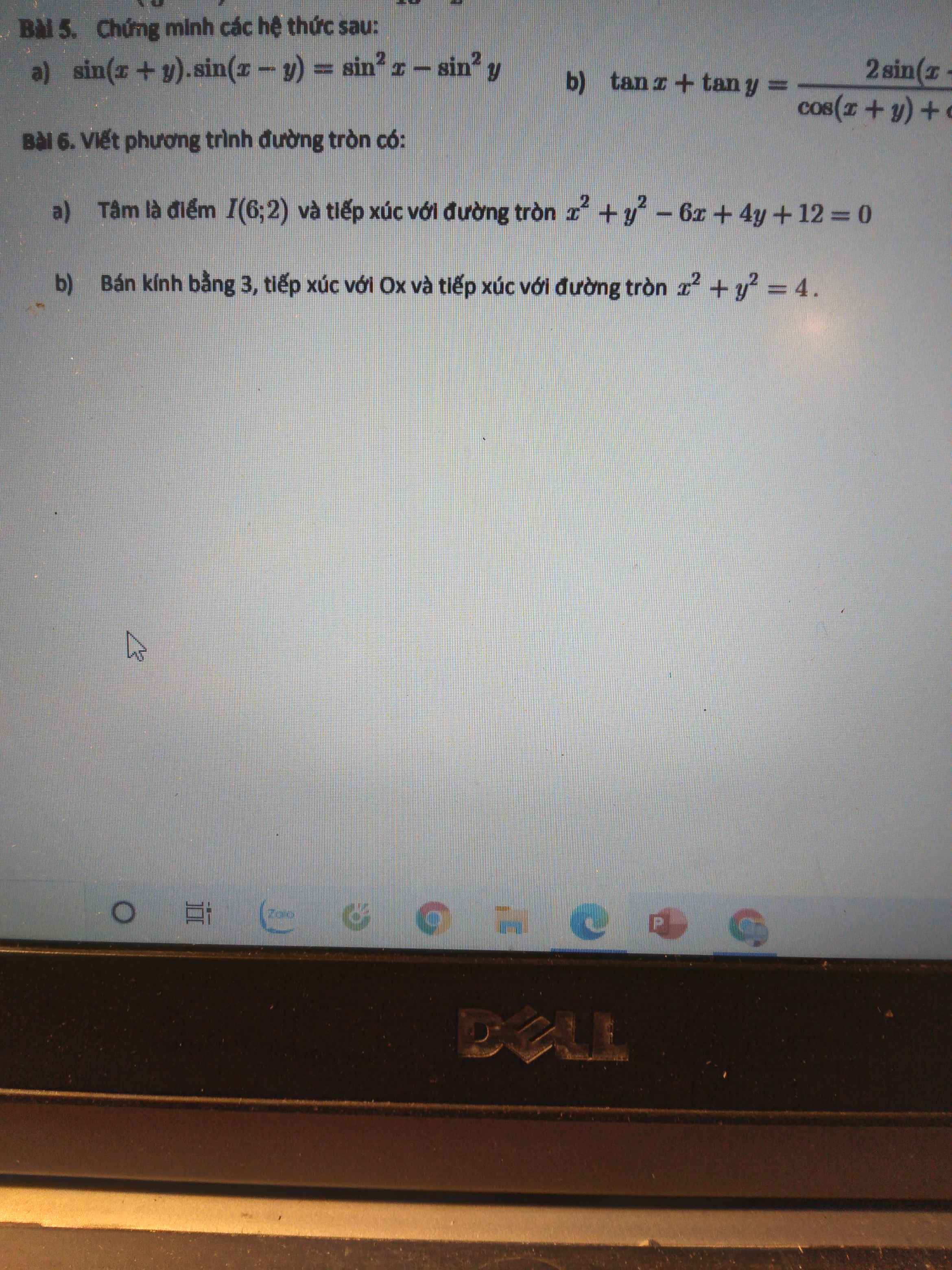


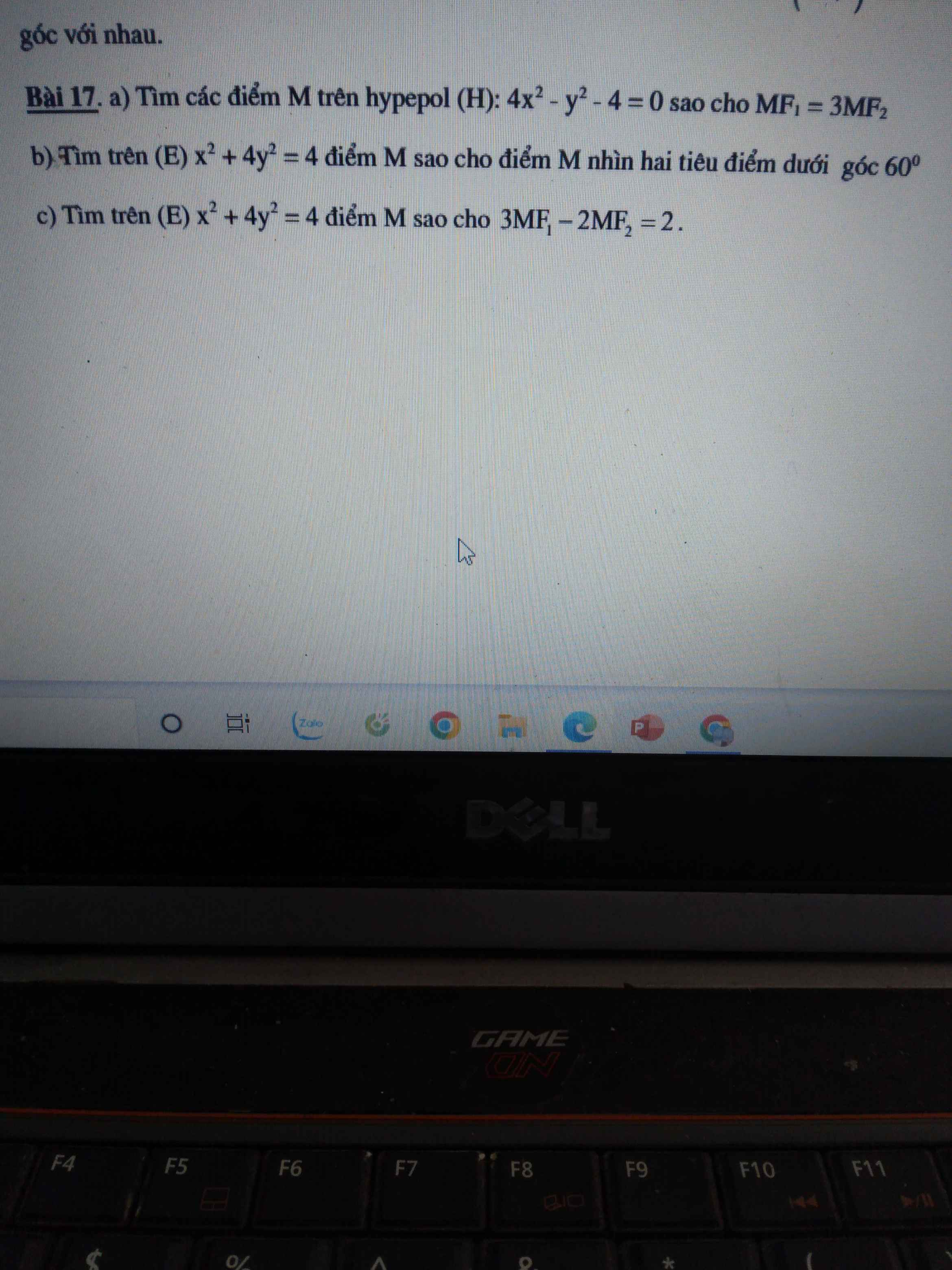
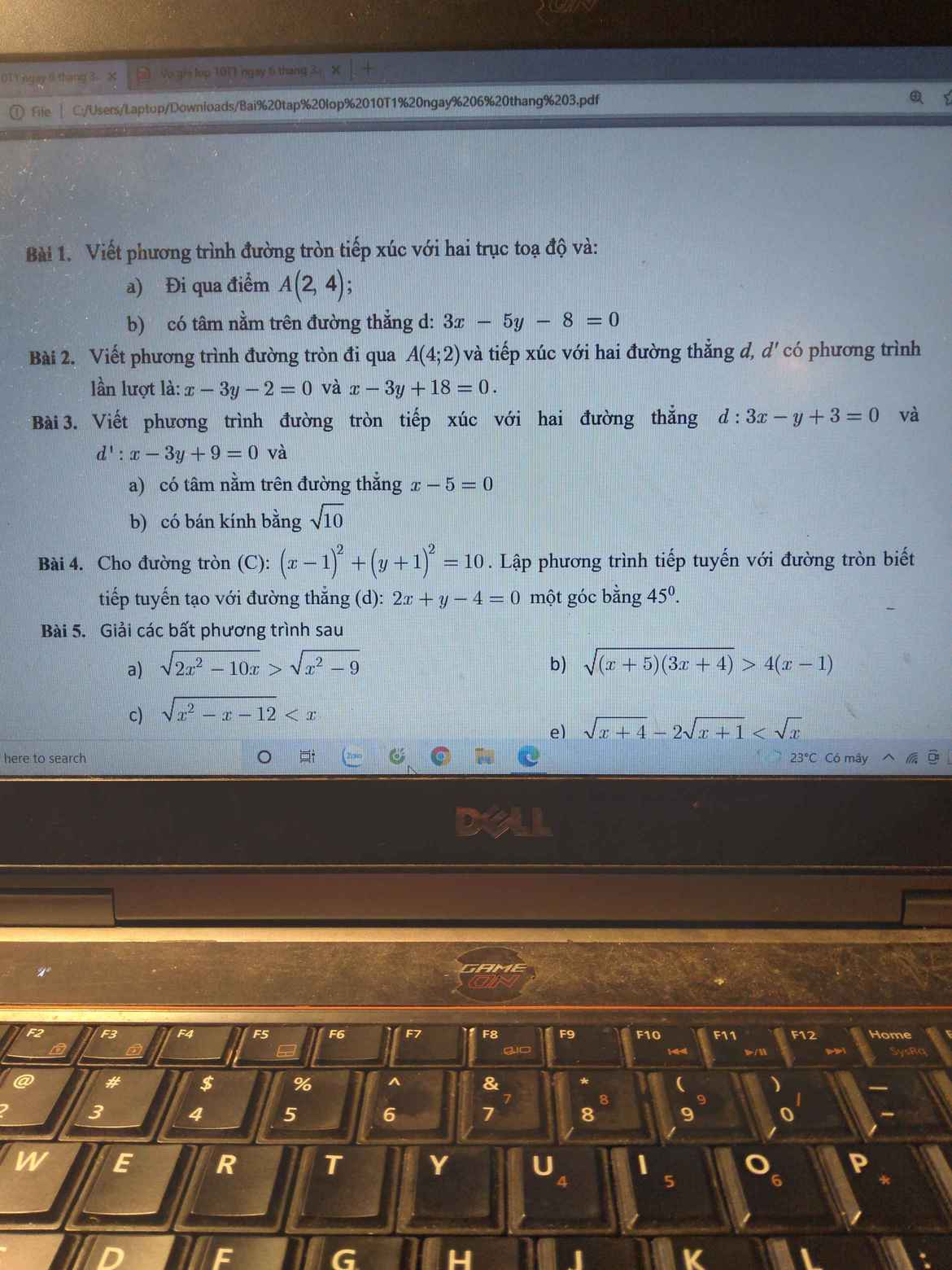

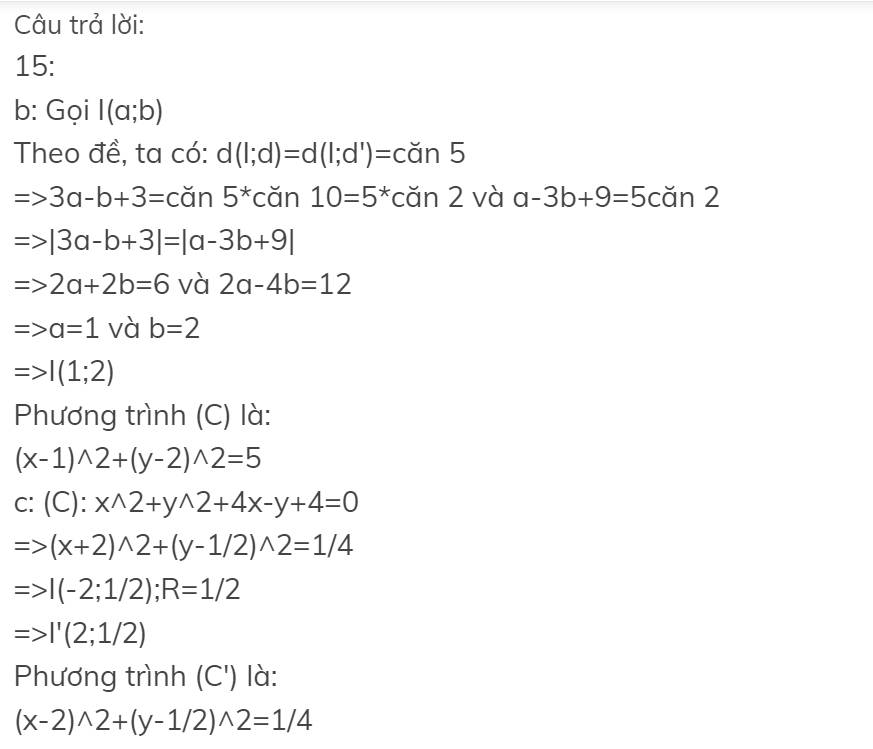

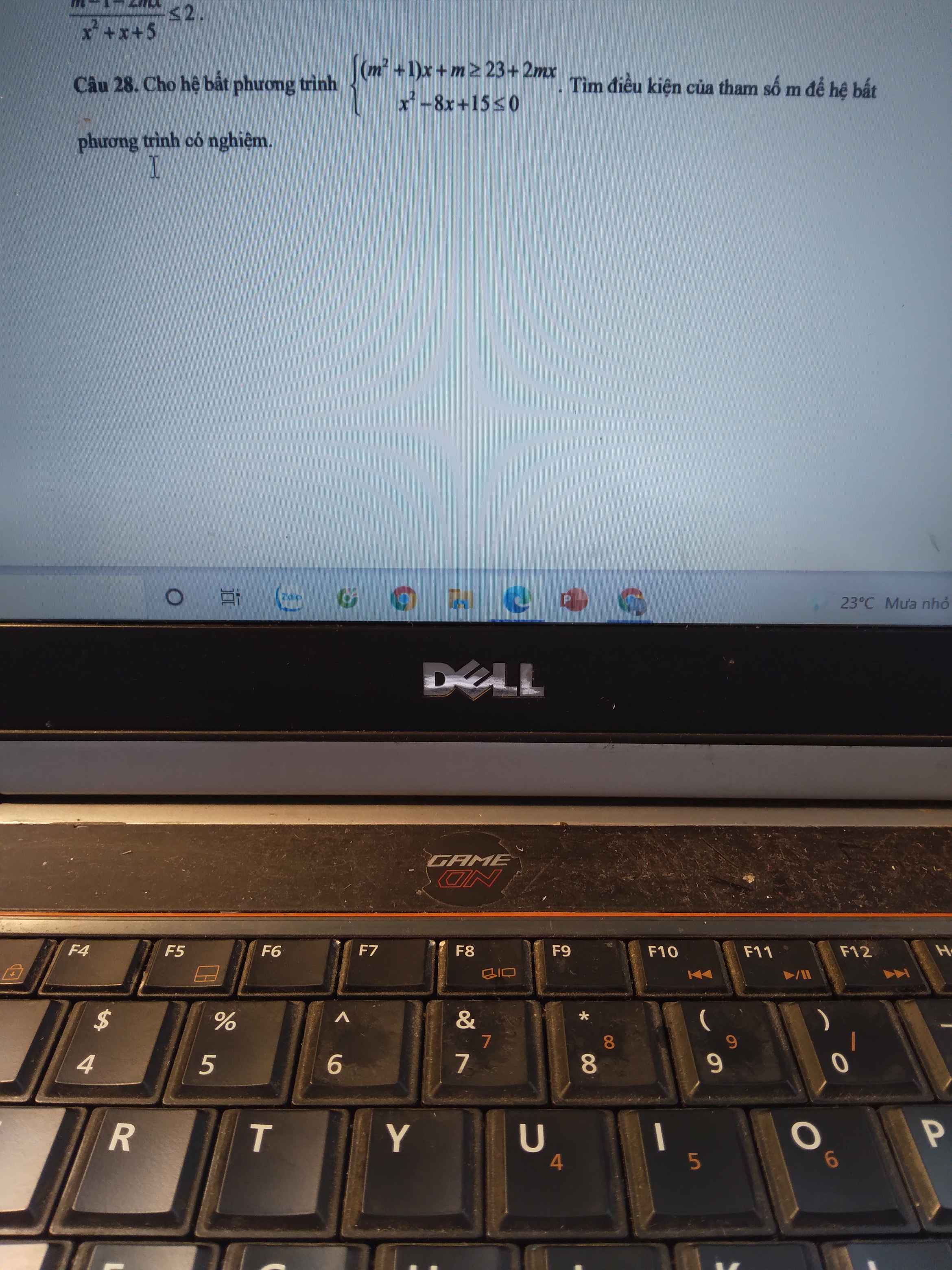

4:
a: -90<a<0
=>cos a>0
cos^2a=1-(-4/5)^2=9/25
=>cosa=3/5
\(sin\left(45-a\right)=sin45\cdot cosa-cos45\cdot sina=\dfrac{\sqrt{2}}{2}\left(cosa-sina\right)\)
\(=\dfrac{\sqrt{2}}{2}\left(\dfrac{3}{5}-\dfrac{4}{5}\right)=\dfrac{-\sqrt{2}}{10}\)
b: pi/2<a<pi
=>cosa<0
cos^2a+sin^2a=0
=>cos^2a=16/25
=>cosa=-4/5
tan a=3/5:(-4/5)=-3/4
\(tan\left(a+\dfrac{pi}{3}\right)=\dfrac{tana+\dfrac{tanpi}{3}}{1-tana\cdot tan\left(\dfrac{pi}{3}\right)}\)
\(=\dfrac{-\dfrac{3}{4}+\sqrt{3}}{1-\dfrac{-3}{4}\cdot\sqrt{3}}=\dfrac{48-25\sqrt{3}}{11}\)
c: 3/2pi<a<pi
=>cosa>0
cos^2a+sin^2a=1
=>cos^2a=25/169
=>cosa=5/13
cos(pi/3-a)
\(=cos\left(\dfrac{pi}{3}\right)\cdot cosa+sin\left(\dfrac{pi}{3}\right)\cdot sina\)
\(=\dfrac{5}{13}\cdot\dfrac{1}{2}+\dfrac{-12}{13}\cdot\dfrac{\sqrt{3}}{2}=\dfrac{5-12\sqrt{3}}{26}\)